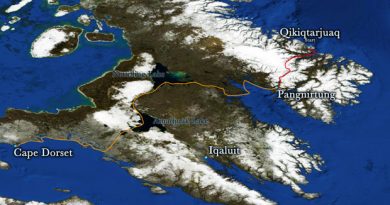New road signs to raise visibility of Tlingit language in Canada’s northwestern Yukon territory

‘Tlingit could become more of a living language ‘ said local resident who helped with project
The next time you drive through the community of Teslin, Yukon, you may notice some new road signs.
The Teslin Tlingit Council has erected approximately 50 signs that read both in English and Tlingit.
Tim Hall, language coordinator with the Teslin Tlingit Council (TTC), says the language revitalization initiative started a few years ago but there were interruptions along the way.
“It’s sort of like a few people work on it and then leave it be,” Hall said.
“It’s kind of gone on like that for a few years but we’ve always had this intention of making public signage in Teslin bilingual.”
Project restarted
Hall says in 2019, First Nation member Mike Hodgeson took the initiative to start the project up again.
“Tlingit could be more of a living language,” Hodgeson said.
“It could be such a simple thing, where people start using the word ‘stop’ in Tlingit. Or ‘enter’ or ‘exit.’ It could become second-hand.”
Hodgeson first came to Teslin in 1981.
“When I came here [ in 1981], Tlingit was still being spoke on the street corner,” he said.
“Over the last 40 years, it’s just stopped.”
Besides road signs, Hodgeson would like to see local stores using “open” and “closed” signs that are in Tlingit.
Making the language more visible and prominent
For the road sign project, the TTC also enlisted fluent Tlingit speakers Bessy Cooley and Sam Johnston to help out.
“They’re the two speakers who provided the translations on the road signs we’re working on,” Hall said.
“Someone like me just asks what the answer is and I write it down. They’re the ones that actually have the knowledge.”
Hall says there are a few different language revitalization projects on the go, but creating bilingual signs for the community was an easy decision.
He says the goal is “to make the language more visible to people and more prominent.”
Now the goal is to have signs along the Alaska Highway in the area translated to Tlingit.
“There’s only a few of them, and fairly close to Teslin.”
Hall also hopes to see the village’s street-name signs translated, as well.
The goal behind the Teslin Tllingit Council’s language revitalization initiatives are to share the First Nation’s language and culture with all of those who live and visit their traditional territory.
Related stories from around the North:
Canada: Inuit TV coming to Northern Canada from new Inuktut-language broadcaster, CBC News
Finland: Everyone encouraged to boost Sami language visibility in Finland, Norway and Sweden this week, Eye on the Arctic
Norway: Walt Disney Animation Studios to release Saami-language version of “Frozen 2”, Eye on the Arctic
Sweden: Can cross-border cooperation help decolonize Sami-language education, Eye on the Arctic
United States: Inuit leaders applaud UN move to designate International Decade of Indigenous Languages, Eye on the Arctic


